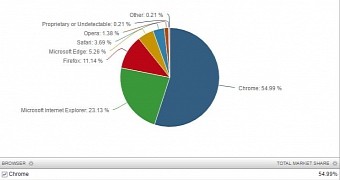Microsoft replaced Internet Explorer with Edge in Windows 10 in an effort to provide users with a more advanced browser that can also compete against the likes of Google Chrome and Mozilla Firefox, which are both winning the browser war at the moment.
But statistics are showing that Microsoft is having a really hard time making Edge more widely adopted, and the limited availability of the browser has a substantial impact on its market share.
The latest batch of data provided by NetMarketShare shows that Edge is indeed improving, but it’s all happening at a terribly slow pace, even though Microsoft has already shipped updates that were supposed to help boost adoption substantially.
Google Chrome has 10 times more users than Edge
For example, the recently-released Windows 10 Anniversary Update, whose rollout started in early August, brought support for extensions and other small tweaks here and there, but this hasn’t helped Edge too much in the race against the other browsers on the market.
In October, Google Chrome was the leading desktop browser with a share of 54.99 percent, while Microsoft’s old Internet Explorer was the runner-up with 23.13 percent. Mozilla Firefox reached the third place with 11.14 percent, while Microsoft Edge was fourth with 5.26 percent.
But although it’s fourth in the charts, Microsoft Edge is improving at a pace that can’t impress anyone. For instance, the new Windows 10 browser had a share of 5.09 percent in June and gradually improved every month to eventually reach 5.26 percent. Last month, it only scored a growth of 0.10 percent.
Microsoft, however, is very keen on improving Edge browser and the company plans to release more new features and tweaks in the coming Windows 10 Creators Update due in the spring. The firm is testing all these improvements with help from users who are participating in the Windows Insider program and installing preview builds of the next OS update.

 14 DAY TRIAL //
14 DAY TRIAL //